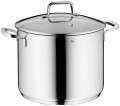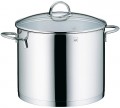Bottom diameter
This parameter is used in order to evaluate the compatibility of the pan with a particular burner on the stove. It acquires particular importance if the product is planned to be used on an electric stove: the diameter of the burner must be at least not less than the diameter of the bottom, otherwise the heating will turn out to be uneven and inefficient. And in induction electric stoves, these diameters must match at all. The selection of suitable pans is somewhat simplified by the fact that modern stoves and hobs usually have burners of different diameters, and in some models, the heaters can even be adjusted in size — up to autofocus in individual induction instances. However, even in cases like this, it doesn't hurt to clarify whether the pan fits into the range of suitable sizes.
Volume
Working volume (capacity) of the pan. For sets (see "Type"), which include dishes of different sizes, values are given in this paragraph for all items.
A large volume allows you to cook a large amount of product at a time, but it affects the dimensions and weight of the pan. Therefore, the optimal capacity for different cases will also be different — depending on the amount of cooking and the type of dish. So, for classic pots,
3 – 4 L is considered a universal option: in such dishes it is convenient to cook soups and compotes for an average family. Models with a capacity
of 2 – 3 liters are also popular — they are convenient for cooking side dishes, as well as small amounts of cooking (for 1 – 2 people). The smallest pans have a volume
of less than 1 liter, they are suitable, in particular, for boiling eggs and heating milk. And the largest ones contain
more than 10 liters, such dishes are designed mainly for catering and public events.
There are also more detailed recommendations on the choice of volume, including for other types of dishes — ladles, milk jugs, etc. (see "Type"); these recommendations can be found in special sources.
Depth
The nominal depth of the pot. In most cases, it is a secondary parameter: the manufacturer selects the depth in accordance with the type, size and volume of dishes, and when choosing, you should first of all focus on these characteristics (for more details, see above).
More features
—
Compatible with induction. Compatibility of a pan with electric heaters of induction type. Such heaters have specific requirements for dishes — in particular, the bottom must be flat and made of certain metals; therefore, it is best to use pans that initially allow use with induction.
—
Dishwasher safe. Possibility of washing the pan in the dishwasher. Not all dishes are compatible with such machines due to dimensions, material characteristics, etc.; and therefore, if you plan to wash the pan in the dishwasher, you should separately make sure that it is compatible.
—
Use in the oven. Possibility of using the pan for cooking in the oven — baking, simmering, etc. The main requirement in this case is resistance to high temperatures. Accordingly, pans with this feature must have metal handles (or
the ability to remove handles if the latter are made of less heat-resistant materials). Non-stick coating is not an obstacle for use in the oven, however, with some of its varieties you need to be careful; see "Coating" for details.
—
Cover with temperature sensor. Availability in a set of delivery of a cover with the built-in sensor displaying temperature in a pan. Such a sensor makes it easier to monitor the degree of heating of the product inside and, accordingly, helps to fine-tune
...the cooking mode. Among the shortcomings, one can note the incompatibility of such covers with ovens and, most often, with dishwashers (see above). And the price of pans in the presence of a temperature sensor increases accordingly. Note that if this function is not regularly provided, a cover of the appropriate size can be purchased separately.
— Funnel for seasonings. The presence of a funnel for seasonings in the regular lid of the pan. Such a funnel is usually located in the centre of the lid and is aligned with the handle. Its purpose is the uniform supply of liquid seasonings (vinegar, wine, oil, etc.) to the dish being prepared: the liquid is poured into a funnel, from which it gradually flows into the pan through a small hole. In addition, many of these funnel handles have a dual purpose — their shape allows you to put the lid handle down and use it as a stand for hot dishes.
— Hole for steam. The presence of a hole for steam in the lid of the pan. High steam pressure is good in pressure cookers (see "Type"), but in normal mode it is not always desirable, because. can lead to the formation of foam and the “escape” of the prepared product, with all the corresponding troubles — such as pollution of the stove, or even extinct gas. To avoid this, you have to slightly open the lid, moving it from the centre of the pan. However, this creates another danger — the lid is not secure and can slip off if not properly positioned. The steam hole eliminates both inconveniences: the lid can lie securely in its regular place, at the same time, excess pressure will still be bled off.
— Drain hole. The presence of a specific detail in the design of the pan, which facilitates the draining of liquid from it. The name "hole" is rather arbitrary — usually it refers to a spout or groove on the top edge of the pan. Such a groove directs and narrows the flow of liquid, which is very useful when draining into another vessel, especially if this vessel has a narrow neck (for example, when you need to pour freshly brewed compote into a bottle). And in the most advanced versions, a peculiar design of the lid is also provided: in the part that is opposite the drain hole, holes are made or a mesh is installed. Due to this, the lid can act as a strainer, releasing liquid from the pan and retaining other contents inside.
— Multi-layered bottom. The presence of a multi-layered bottom in the design of the pan. This function is most often used in steel models, occasionally in aluminium (see "Material"). Such a bottom most often has three layers: outer and inner from the main material of the pan, and between them — a layer of another substance, more heat-conducting and heat-intensive (for example, copper). Due to this, much faster and more uniform heating is provided, and such dishes cool down more slowly than single-layer ones.
— Displacement scale. A special scale applied inside the pan and allowing with a certain degree of accuracy to determine the volume of products inside. This function is especially useful for those who like to cook in the maximum accordance with recipes.
— Detachable handles. Possibility to detach the handle (or handles) from the pot. This function has two main purposes. Firstly, it makes the dishes more compact, which is useful for storage and transportation. Secondly, such an opportunity is often critical for using dishes in the oven (see above): a long handle may simply not fit there, and some materials (see “Handles”) are not designed for the oven in principle.
